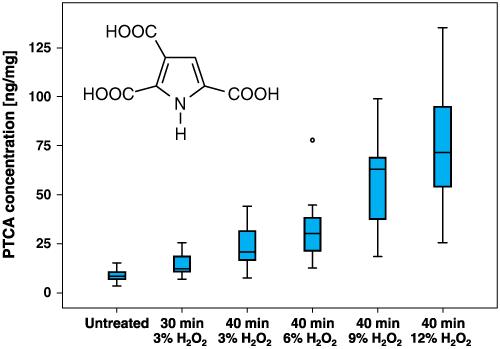当前位置:
X-MOL 学术
›
Drug Test. Anal.
›
论文详情
Our official English website, www.x-mol.net, welcomes your
feedback! (Note: you will need to create a separate account there.)
PTCA (1H‐pyrrole‐2,3,5‐tricarboxylic acid) as a marker for oxidative hair treatment
Drug Testing and Analysis ( IF 2.6 ) Pub Date : 2017-11-17 , DOI: 10.1002/dta.2305 Silvana Petzel-Witt 1 , Sylvia I. Meier 1 , Manfred Schubert-Zsilavecz 2 , Stefan W. Toennes 1
Drug Testing and Analysis ( IF 2.6 ) Pub Date : 2017-11-17 , DOI: 10.1002/dta.2305 Silvana Petzel-Witt 1 , Sylvia I. Meier 1 , Manfred Schubert-Zsilavecz 2 , Stefan W. Toennes 1
Affiliation

|
Hair analysis for the assessment of alcohol or drug abstinence has become a routine procedure in forensic toxicology. Hair coloration leading to loss of incorporated xenobiotics and to false negative results has turned out to be a major problem. Currently only colored extracts provide hints of manipulations but not bleaching. A liquid chromatographic–tandem mass spectrometric (LC–MS/MS) method was developed and validated to determine 1H‐pyrrole‐2,3,5‐tricarboxylic acid (PTCA), a major oxidation product of melanin. PTCA was determined in natural hair samples (n = 21) after treatment with 3% hydrogen peroxide (H2O2) for 30 or 40 minutes with concentrations up to 12% for 40 minutes. In another series, 12 natural hair samples were submitted to different coloration procedures (henna, tinting, semi‐permanent and permanent dyeing, bleaching) and the changes in PTCA content were determined. A significant increase in the PTCA content was found for both incubation times and increasing H2O2 concentrations. Coloration with henna or tinting had no influence on PTCA levels detected, but a significant increase was observed after semi‐permanent and permanent dyeing and bleaching. As PTCA concentrations in natural hair were found to be in a range of <2.1–16.4 ng/mg (8.4 ± 3.8 ng/mg, mean ± SD, n = 33), a cut‐off of 20 ng/mg is recommended for the distinction between natural vs. excessively oxidized hair. In case of naturally low melanin content (light‐blond or white hair), no marked increase in PTCA may occur. The present study demonstrated that PTCA is formed during oxidative treatment of melanin in hair, which can be used to detect previous hair coloration including oxidation.
中文翻译:

PTCA(1H-吡咯-2,3,5-三羧酸)作为氧化性头发护理的标记
进行酒精或药物戒断评估的头发分析已成为法医毒理学中的常规程序。染发导致掺入的异种生物损失和假阴性结果已成为一个主要问题。目前,只有彩色提取物能提供操作提示,但不能漂白。液相色谱-串联质谱(LC-MS / MS)方法得到了开发和验证,可以测定黑色素的主要氧化产物1H-吡咯-2,3,5-三羧酸(PTCA)。在3%过氧化氢(H 2 O 2)处理后,在自然头发样品(n = 21)中测定PTCA。)30或40分钟,浓度达12%的40分钟。在另一个系列中,将12种天然头发样品进行了不同的染色程序(染色,染色,半永久性和永久性染色,漂白),并确定了PTCA含量的变化。发现孵育时间和增加的H 2 O 2均使PTCA含量显着增加。浓度。指甲红染或着色对检测到的PTCA水平没有影响,但在半永久性和永久性染色和漂白后观察到显着增加。由于发现自然头发中的PTCA浓度在<2.1–16.4 ng / mg(8.4±3.8 ng / mg,平均值±SD,n = 33)范围内,因此建议将其阈值为20 ng / mg自然与过度氧化的头发之间的区别。如果黑色素含量自然较低(浅色或白色头发),则PTCA不会显着增加。本研究表明,PTCA是在头发中黑色素的氧化处理过程中形成的,可用于检测以前的头发着色(包括氧化)。
更新日期:2017-11-17
中文翻译:

PTCA(1H-吡咯-2,3,5-三羧酸)作为氧化性头发护理的标记
进行酒精或药物戒断评估的头发分析已成为法医毒理学中的常规程序。染发导致掺入的异种生物损失和假阴性结果已成为一个主要问题。目前,只有彩色提取物能提供操作提示,但不能漂白。液相色谱-串联质谱(LC-MS / MS)方法得到了开发和验证,可以测定黑色素的主要氧化产物1H-吡咯-2,3,5-三羧酸(PTCA)。在3%过氧化氢(H 2 O 2)处理后,在自然头发样品(n = 21)中测定PTCA。)30或40分钟,浓度达12%的40分钟。在另一个系列中,将12种天然头发样品进行了不同的染色程序(染色,染色,半永久性和永久性染色,漂白),并确定了PTCA含量的变化。发现孵育时间和增加的H 2 O 2均使PTCA含量显着增加。浓度。指甲红染或着色对检测到的PTCA水平没有影响,但在半永久性和永久性染色和漂白后观察到显着增加。由于发现自然头发中的PTCA浓度在<2.1–16.4 ng / mg(8.4±3.8 ng / mg,平均值±SD,n = 33)范围内,因此建议将其阈值为20 ng / mg自然与过度氧化的头发之间的区别。如果黑色素含量自然较低(浅色或白色头发),则PTCA不会显着增加。本研究表明,PTCA是在头发中黑色素的氧化处理过程中形成的,可用于检测以前的头发着色(包括氧化)。

































 京公网安备 11010802027423号
京公网安备 11010802027423号